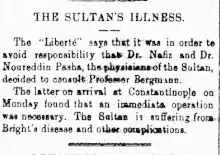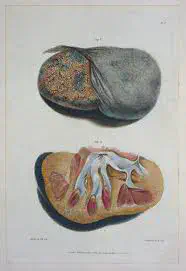The Sultan's Kidney Disease
A Medical Analysis
 Sultan’s Illness Described
Sultan’s Illness DescribedIn the month of September issues of the Egyptian Gazette, the newspaper talks about the Sultan's illness. Specifically, in page three of the September 21st issue of 1906, the Sultan is mentioned and the author says he has Bright's disease. This disease was named after Richard Bright, a physician. It was a disease pertaining to the kidney, but was later discovered to be a classification of a variety of kidney diseases that were unknown at the time.

A patient with this disease could experience swelling, convulsions, blindness, and coma. A lot of patients with this disease may have also had high blood pressure, heart disease, or diabetes. The newspaper mentions Dr. Nafiz, and Dr. Noureddin Pasha as the primary physicians of the Sultan, but it mentions that they had to consult Professor Bergmann for assistance. Bergmann was the one to diagnose the Sultan with Bright's disease, and ordered an immediate surgical operation. He also says that he is suffering from "other complications," which may be anything from diabetes to heart disease to kidney failure.
Today, a patient with the same symptoms would be likely diagnosed with chronic nephritis, which is an inflammation of the kidney. However, in the Thursday issue, it is mentioned that the Sultan was suffering from a stone. This means that he may have had a urinary tract infection. The most common cause of a UTI is Escherichia coli, or similar fungi. Other causes may include genetic predisposition or being uncircumcised. What exactly caused the Sultan to be ill is unknown, however, the diagnosis at the time was based on similar cases. Richard Bright attributed the disease to high blood pressure and diabetes, which could have been true in the Sultan's case, as he mourned the recent death of two high functionaries, one of which "enjoyed his majesty's confidence."